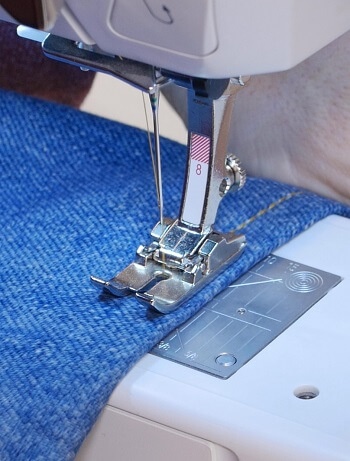 Most people try to avoid denim fabric because it is thick, meaning that its thicker seams are much harder to work with. However, sewing denim is not that difficult if done correctly.
Most people try to avoid denim fabric because it is thick, meaning that its thicker seams are much harder to work with. However, sewing denim is not that difficult if done correctly.
Before even diving into the best way of sewing this material, you should have a sewing machine with a powerful motor so that it can puncture through the thick layers easily.
The machine should also have a high presser foot lift so that these thick seams can fit under it with ease. Another desirable feature would be a large working table so that you can level the denim fabric for a more comfortable sewing experience. With such a sewing machine in place, below are some of the tips that can help you sew the perfect denim stitches.
Steam and heat
Being a thick and tough material, denim might bend and form ripples after stitching, which is not a good result. The key to avoiding this outcome is to steam and heat the fabric using a steam iron to soften the fabric and make it “loosen up” a little bit.
Apart from preventing these ripples, the softening also makes it easier to puncture through, giving the sewing machine an easier time doing its job.
Use heavy-duty needles (specifically meant for denim)
Apart from using a machine with a strong motor, you need heavy-duty needles for this job. There is a big difference between all-purpose needles and needles marked with a “jeans” tag. Jeans needles are much thicker, and therefore ideal for puncturing through heavy fabrics. The smaller 90/14 size needles can work on light denim, but heavy denim requires 100/16 or 100/18 sized needles.
Use heavy-duty thread
This type of thread is particularly good for topstitching, which reinforces the seams, enabling them to handle stress easily. Thick, heavy-duty threads also have a decorative effect when used for topstitching and, thus, also give the denim joints a good look.
Hold it firmly when sewing
This is why you need a machine with a large working table. Sometimes denim might stretch or compact if not held firmly. While sewing, you need to hold it firmly both on the front side and backside of the needle.
A large working table would be ideal to do this because you will have enough space in front of and behind the needle to place your hands on the fabric as you guide through the presser foot.
Use a longer stitch length
Being quite tough, denim can still hold itself together when sewn using long stitches. The recommended stitch length is about 3mm, and this gives you just enough space to hold enough denim fibers per stitch. A longer stitch length also reduces strain on the needle and machine motor because they puncture fewer holes per given length.
Go slow
When you encounter these thick seams, it might be necessary to hand crank the wheel at times so that you do not damage the motor as well as the needles.
Conclusion
Even as you strive to make these durable stitches, your denim design will still be weak if it is not finished off by strong closures. Heavy-duty zippers, snaps, and buttons should be used so that the entire final design is durable and strong enough to handle a reasonable amount of stress.